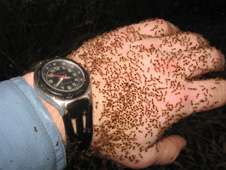Critter control, au natural

(�鶹��ԺOrg.com) -- It’s surprising how much havoc the tiny termite can wreak. Each year infestations of these insects cause an estimated $30 billion in damage to buildings and crops nationwide. Historically, homeowners and plantation farmers have resorted to using harmful chemical pesticides to kill off the pests, but new research out of Northeastern University may soon change that.
Rebeca Rosengaus, an associate professor of biology at Northeastern, along with former Northeastern postdoctoral fellow Mark Bulmer and a team of MIT researchers, has discovered an environmentally friendly method of pest control.
Rosengaus and her colleagues found that the sugar analogue glucono delta-lactone (GDL), a naturally occurring food additive, inhibits termites’ immunity against pathogenic microorganisms that typically colonize termite nests.
The key to unlocking GDL’s pest-control potential lay in uncovering how termites remain disease-free while living in bacteria- and fungus-ridden nests. The answer, researchers found, was due in part to the protective effect of a specific type of protein, known as gram-negative bacteria binding proteins (GNBPs), present in termite saliva and fecal matter. GNBPs, it turns out, destroy fungus and bacteria.
The addition of GDL, however, inhibits the fungus-fighting proteins from working their magic. Termites exposed to the glucose derivative succumb to disease much faster than those who aren’t.
“All termites fed GDL died five days after exposure to a fungus, whereas the control showed roughly 70 percent survival 12 days post-fungal infection,” Rosengaus says of the lab-test results.
The findings could usher in a new wave of pest control, she notes—one that could replace the toxic approach used for the past several decades. This is good news for the health of animals, humans and the environment. “It has been found that toxic compounds are bad for the environment and bad for human health,” Rosengaus explains. “They have a very long half-life; they can also leech into the water with potential harmful effects to other animals, including humans.”
“GDL is a simple, cost-effective molecule,” she explains further. “It’s biodegradable, so it’s not loading the environment with nasty chemicals.”
She is hopeful that her team’s method of pest control will hold up in further field studies, especially in urban areas where termites are a particular problem.
“We’re far away from saying this is the future of pest control, but it seems a very appealing alternative strategy,” she says.
The findings were reported in the June 8 issue of the Proceedings of the National Academy of Sciences.
Provided by Northeastern University ( : )

















